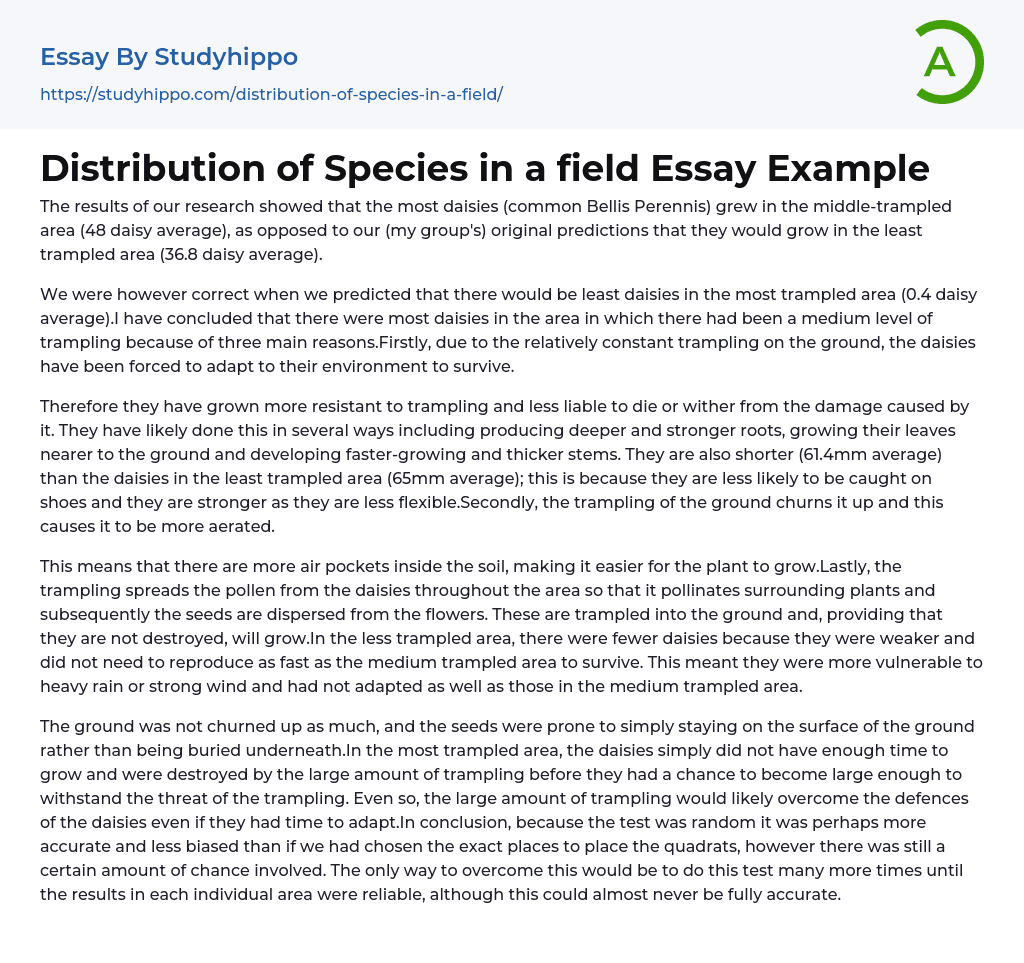Our research revealed that the common Bellis Perennis daisies thrived the most in the area with the most trampling, with an average of 48 daisies, despite our initial assumption that they would grow best in the least trampled area, which had an average of 36.8 daisies.
Our prediction about the least number of daisies in the most trampled area (0.4 daisy average) turned out to be accurate. I have reached the conclusion that the area with a medium level of trampling had the highest number of daisies based on three main reasons. Firstly, constant trampling has forced the daisies to adapt to their environment to survive.
As a result of trampling, daisies have become more resistant and less likely to wither or die. They achieve this through deeper and stronger root production, growing leaves nearer to the ground, and faster-growing and thic
...ker stem development. Additionally, their shorter height of 61.4mm, compared to 65mm in the least trampled area, makes them less likely to get caught on shoes and harder as they are less flexible. Furthermore, trampling churns up the ground and increases aeration.
By being trampled, the soil contains more air pockets that facilitate the growth of plants. Additionally, trampling also helps in pollinating the area as the pollen from daisies are spread and the resulting seeds are dispersed into the ground. However, in areas with less trampling, daisies were weaker and reproduced at a slower rate, making them more vulnerable to harsh weather conditions. The medium trampled area had better-adapted daisies that could survive such conditions.
The seeds on the surface of the ground were more prone to remaining there rather than being buried due to les
churned ground. Daisies weren't able to grow in the most trampled area because they were destroyed before becoming strong enough to withstand further trampling. Even with adaptation time, the daisies' defences would likely be overwhelmed by trampling. The random test may have been more accurate and less biased than selecting specific quadrat locations, but still involved chance. Conducting this test numerous times in each area is the only way to obtain reliable results, but full accuracy may never be achieved.
- Microbiology essays
- Bacteria essays
- Cell essays
- Enzyme essays
- Photosynthesis essays
- Plant essays
- Natural Selection essays
- Protein essays
- Viruses essays
- Cell Membrane essays
- Human essays
- Stem Cell essays
- Breeding essays
- Biotechnology essays
- Cystic Fibrosis essays
- Tree essays
- Seed essays
- Coronavirus essays
- Zika Virus essays
- Agriculture essays
- Albert einstein essays
- Animals essays
- Archaeology essays
- Bear essays
- Biology essays
- Birds essays
- Butterfly essays
- Cat essays
- Charles Darwin essays
- Chemistry essays
- Dinosaur essays
- Discovery essays
- Dolphin essays
- Elephant essays
- Eli Whitney essays
- Environmental Science essays
- Evolution essays
- Fish essays
- Genetics essays
- Horse essays
- Human Evolution essays
- Isaac Newton essays
- Journal essays
- Linguistics essays
- Lion essays
- Logic essays
- Mars essays
- Methodology essays
- Mineralogy essays
- Monkey essays




